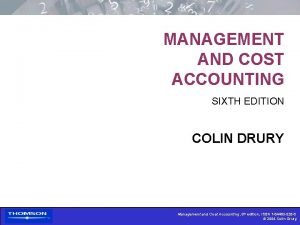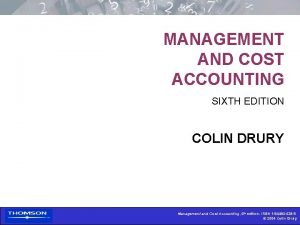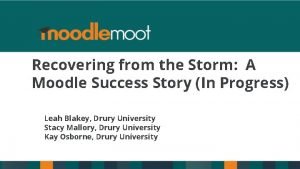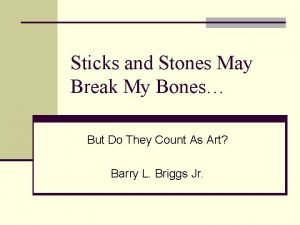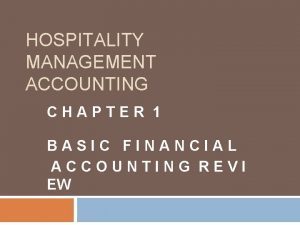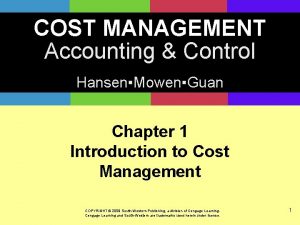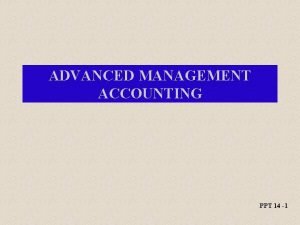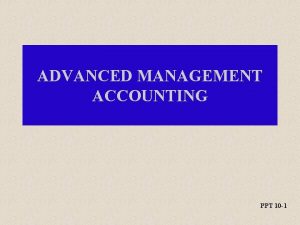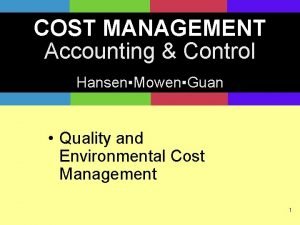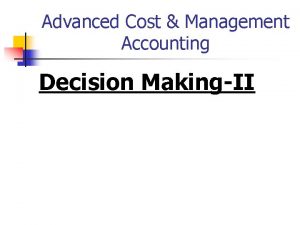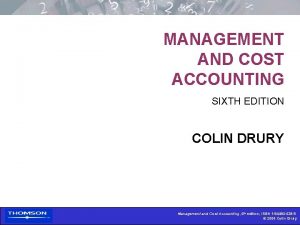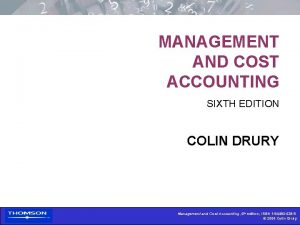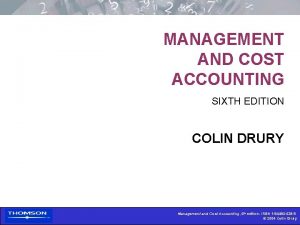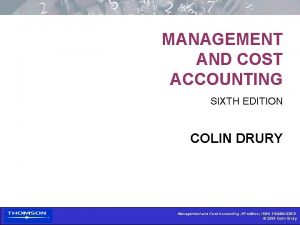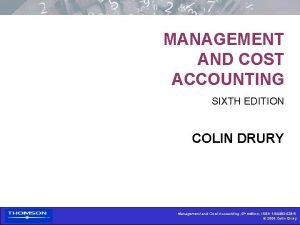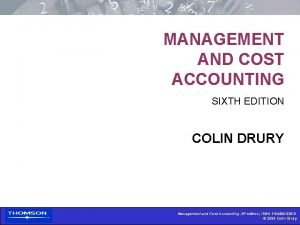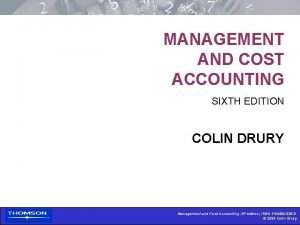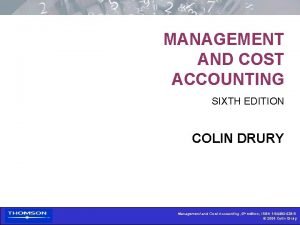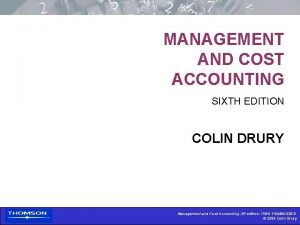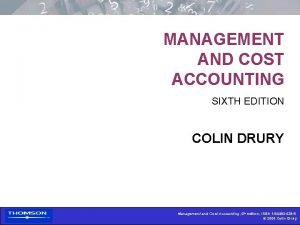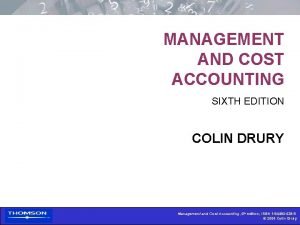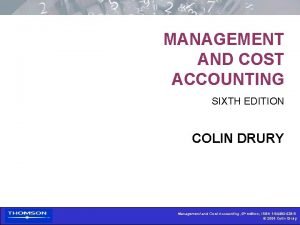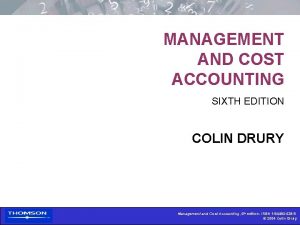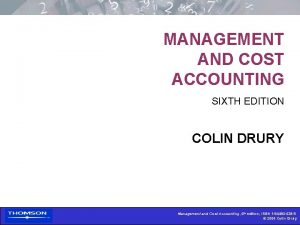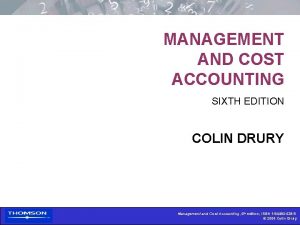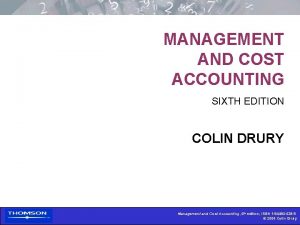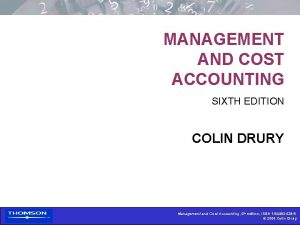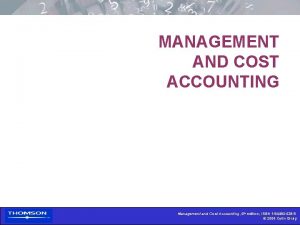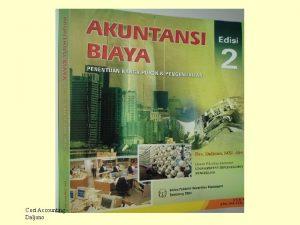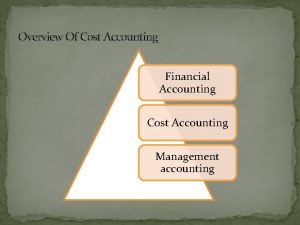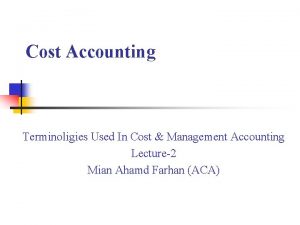MANAGEMENT AND COST ACCOUNTING SIXTH EDITION COLIN DRURY




























- Slides: 28

MANAGEMENT AND COST ACCOUNTING SIXTH EDITION COLIN DRURY Management and Cost Accounting, 6 th edition, ISBN 1 -84480 -028 -8 © 2000 Colin Drury © 2004 Colin Drury

Part Two: Cost accumulation for inventory valuation and profit measurement Chapter Five: Process costing Management and Cost Accounting, 6 th edition, ISBN 1 -84480 -028 -8 © 2000 Colin Drury © 2004 Colin Drury

5. 1 PROCESS COSTING 1. Job costing assigns costs to each individual unit of output because each unit consumes different quantities of resources. 2. Process costing does not assign costs to each unit of output because each unit is identical. Instead, average unit costs are computed. Management and Cost Accounting, 6 th edition, ISBN 1 -84480 -028 -8 © 2000 Colin Drury © 2004 Colin Drury

5. 2 a A comparison of job & process costing Management and Cost Accounting, 6 th edition, ISBN 1 -84480 -028 -8 © 2000 Colin Drury © 2004 Colin Drury

5. 2 b Management and Cost Accounting, 6 th edition, ISBN 1 -84480 -028 -8 © 2000 Colin Drury © 2004 Colin Drury

5. 3 a Normal and abnormal losses • Normal losses cannot be avoided –Cost is absorbed by good production. • Abnormal losses are avoidable –Cost is recorded separately and treated as a period cost. Example Input Normal loss Actual output CPU Cost of completed production Cost of abnormal loss = 1 200 litres at a cost of £ 1 200 = 1/6 of input = 900 litres = £ 1 200/Expected output (1 000 litres) = 1. 20 = £ 1 080 (900 ×£ 1. 20) = £ 120 (100 × £ 1. 20) Management and Cost Accounting, 6 th edition, ISBN 1 -84480 -028 -8 © 2000 Colin Drury © 2004 Colin Drury

5. 3 b Management and Cost Accounting, 6 th edition, ISBN 1 -84480 -028 -8 © 2000 Colin Drury © 2004 Colin Drury

5. 4 a Sale proceeds from normal losses Management and Cost Accounting, 6 th edition, ISBN 1 -84480 -028 -8 © 2000 Colin Drury © 2004 Colin Drury

5. 4 b Management and Cost Accounting, 6 th edition, ISBN 1 -84480 -028 -8 © 2000 Colin Drury © 2004 Colin Drury

5. 5 a Sale proceeds (normal and abnormal losses) Example 2 As example 1 but output CPU as example 1 = 900 litres (abnormal loss = 100 litres) = £ 1. 10 per litre The sales value of the abnormal loss should be offset against the cost of the abnormal loss. Management and Cost Accounting, 6 th edition, ISBN 1 -84480 -028 -8 © 2000 Colin Drury © 2004 Colin Drury

5. 5 b Management and Cost Accounting, 6 th edition, ISBN 1 -84480 -028 -8 © 2000 Colin Drury © 2004 Colin Drury

5. 5 c Management and Cost Accounting, 6 th edition, ISBN 1 -84480 -028 -8 © 2000 Colin Drury © 2004 Colin Drury

5. 6 a Abnormal gains Example Input Output Normal loss Scrap value = 1 200 litres at a cost of £ 1 200 = 1 100 litres = 1/6 of input = £ 0. 50 per litre CPU = Cost of production less scrap value of normal loss Expected output = £ 1 100 /1 000 = £ 1. 10 per litre Management and Cost Accounting, 6 th edition, ISBN 1 -84480 -028 -8 © 2000 Colin Drury © 2004 Colin Drury

5. 6 b Management and Cost Accounting, 6 th edition, ISBN 1 -84480 -028 -8 © 2000 Colin Drury © 2004 Colin Drury

5. 6 c Management and Cost Accounting, 6 th edition, ISBN 1 -84480 -028 -8 © 2000 Colin Drury © 2004 Colin Drury

5. 7 a Equivalent production & closing WIP Partly completed units are expressed as fully completed equivalent units in order to compute CPU (e. g. 1000 units 50% complete equls 500 equivalent production. Example Opening WIP Nil Units introduced into the process 14 000 Units completed and trasferred to next process 10 000 Closing WIP (50% complete) 4 000 Materials cost (introduced at start) £ 70 000 Conversion cost £ 48 000 Note that materials are 100% complete. Management and Cost Accounting, 6 th edition, ISBN 1 -84480 -028 -8 © 2000 Colin Drury © 2004 Colin Drury

5. 7 b Management and Cost Accounting, 6 th edition, ISBN 1 -84480 -028 -8 © 2000 Colin Drury © 2004 Colin Drury

5. 7 b Equivalent production and closing WIP Management and Cost Accounting, 6 th edition, ISBN 1 -84480 -028 -8 © 2000 Colin Drury © 2004 Colin Drury

5. 9 a Previous process cost Costs transferred from a previous process are treated as a separate element of cost (100% complete) Example Opening WIP Units transferred Closing WIP *50% complete) Completed units transferred to finished goods stock Previous process cost Conversion costs Materials (introduced at end of process) Nil 10 000 1 000 9 000 £ 90 000 £ 57 000 £ 36 000 Note materials are zero complete and previous process cost 100% complete. Management and Cost Accounting, 6 th edition, ISBN 1 -84480 -028 -8 © 2000 Colin Drury © 2004 Colin Drury

5. 9 b Management and Cost Accounting, 6 th edition, ISBN 1 -84480 -028 -8 © 2000 Colin Drury © 2004 Colin Drury

5. 10 Previous process cost Management and Cost Accounting, 6 th edition, ISBN 1 -84480 -028 -8 © 2000 Colin Drury © 2004 Colin Drury

5. 11 Example to illustrate weighted average and FIFO Management and Cost Accounting, 6 th edition, ISBN 1 -84480 -028 -8 © 2000 Colin Drury © 2004 Colin Drury

5. 12 and 5. 13 Opening WIP-weighted average method Use Overheads 5. 12 & 5. 13 as transparencies Management and Cost Accounting, 6 th edition, ISBN 1 -84480 -028 -8 © 2000 Colin Drury © 2004 Colin Drury

5. 14 a Opening WIP – FIFO method The FIFO method assumes opening WIP is the first group of units to be completed. Therefore, opening WIP is charged separately to completed production and CPU is based on current period costs. Management and Cost Accounting, 6 th edition, ISBN 1 -84480 -028 -8 © 2000 Colin Drury © 2004 Colin Drury

5. 14 b Management and Cost Accounting, 6 th edition, ISBN 1 -84480 -028 -8 © 2000 Colin Drury © 2004 Colin Drury

5. 15 a Opening WIP – FIFO method Management and Cost Accounting, 6 th edition, ISBN 1 -84480 -028 -8 © 2000 Colin Drury © 2004 Colin Drury

5. 15 b Management and Cost Accounting, 6 th edition, ISBN 1 -84480 -028 -8 © 2000 Colin Drury © 2004 Colin Drury

5. 16 Losses in process and equivalent productions Use Overhead 5. 16 as transparency Management and Cost Accounting, 6 th edition, ISBN 1 -84480 -028 -8 © 2000 Colin Drury © 2004 Colin Drury
 Drury management and cost accounting
Drury management and cost accounting Drury c management and cost accounting
Drury c management and cost accounting Inicum
Inicum The sixth sick sheik's sixth sheep's sick lyrics
The sixth sick sheik's sixth sheep's sick lyrics Biochemistry sixth edition
Biochemistry sixth edition Mallory drury
Mallory drury Sticks and stones origin
Sticks and stones origin Craig drury
Craig drury Mark liebig
Mark liebig Computer architecture a quantitative approach sixth edition
Computer architecture a quantitative approach sixth edition Automotive technology sixth edition
Automotive technology sixth edition Automotive technology sixth edition
Automotive technology sixth edition Apa sixth edition
Apa sixth edition Computer architecture a quantitative approach 6th
Computer architecture a quantitative approach 6th Precalculus sixth edition
Precalculus sixth edition Rational people think at the margin
Rational people think at the margin Computer architecture a quantitative approach sixth edition
Computer architecture a quantitative approach sixth edition Financial accounting chapter 1
Financial accounting chapter 1 Cost management accounting and control
Cost management accounting and control Activity based costing ppt
Activity based costing ppt Role of management accounting ppt
Role of management accounting ppt Cost management accounting and control
Cost management accounting and control Responsibility centers in management accounting
Responsibility centers in management accounting Relevant cost in management accounting
Relevant cost in management accounting Using mis (10th edition) 10th edition
Using mis (10th edition) 10th edition Report
Report Food and beverage cost control 5th edition pdf
Food and beverage cost control 5th edition pdf Cost accumulation and cost assignment
Cost accumulation and cost assignment Cost accumulation and cost assignment
Cost accumulation and cost assignment
